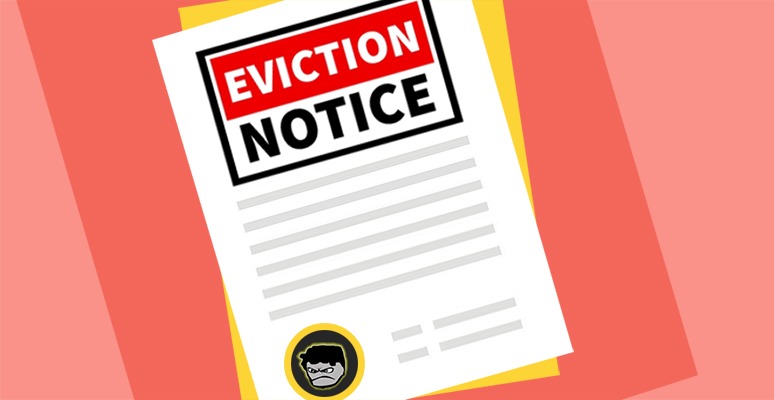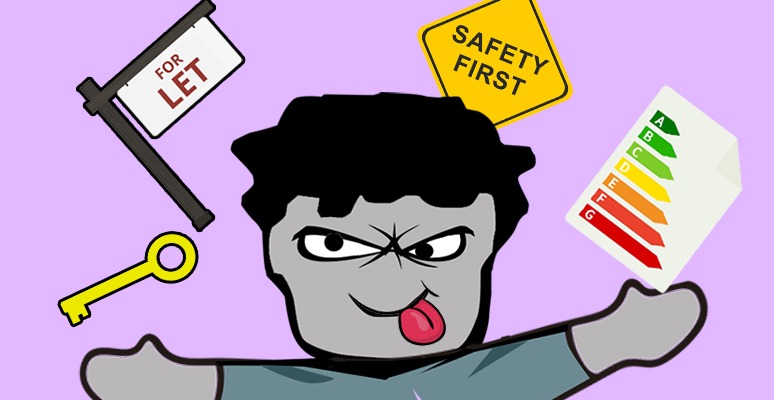
Alas, a terribly common scenario that often leaves landlords in cardiac arrest:
- Tenant pays deposit, signs tenancy agreement and moves into their wonderful new home
- At the end of the tenancy, during the final move-out inspection, reality hits home: the deposit won’t cover the cost of damages or repairs incurred by the tenant(s)
SHHHHIIIT!! What a pickle!
So now what? Don’t worry, I’ve got you.
To clarify, this blog post is specifically intended for ghastly situations where the tenancy deposit does not fully cover the cost of any damages or repairs incurred by the tenant. If you only want to claim the remaining balance of the deposit or less (and nothing more), here is a guide on The Right Way For Landlords To Make A Tenancy Deposit Claim.
Needless to say, I need to make it crystal clear from the jump that I am not offering any legal advice over here (or anywhere else on my blog, as a matter of fact), least of all because I’m woefully under qualified to do so. However, what I do offer is, hopefully, some helpful insights from an experienced landlord on how to navigate these – often treacherous – waters.
As with most tedious situations in life, there isn’t a one-size fits all answer. The best course of action will depend on your specific circumstances, as well as your perspective and appetite for justice. So, allow me to waffle on, and then I’ll leave the decision-making in your capable hands…
Landlord’s first steps to pursuing a claim
Assess the damage and costs of repair
Don’t do a thing, absolutely nothing, before having thoroughly assessed the damages and estimated the repair costs:
- Carefully document the damages (this is typically done during the check-out inspection).
- Obtain quotes or invoices to substantiate the repair costs.
Evidence to support your claim
I’m going to make the assumption that you have sufficient evidence to support your claim. Without it, you’ll struggle to claim your tenant’s security deposit, let alone pursue additional compensation for damages and repair costs that exceed the deposit amount.
If you were a legitimate wally and skipped the inventory report at the start of the tenancy, leaving you with little to no evidence to back up your claim, your options will be painfully limited. In this case, you’ll be left hoping the tenant agrees with your claim and covers the repair costs, as you’ll have little leverage to explore other options. As it goes, you made your bed, so you’re now going to have to lay in it. Hopefully you won’t make the same mistake next time – here’s my complete guide on landlord inventories.
For the best chance of making a successful claim, your evidence should include a detailed inventory report with dated photos, along with clear documentation of any damages or changes to the property.
Consider whether the claim is worth chasing
In my experience, many landlords aren’t practical enough when it comes to decision making at this critical moments, which often leads them into head-banging-wall and unproductive battles.
Nobody likes being taken for a ride – I get it – but the reality is, cost of doing business often includes swallowing expenses that make us feel sick to our stomachs. And that often means coming to terms with a strong sense of injustice.
Before pursuing legal action, it’s worth considering whether the debt is truly worth chasing.
In most cases, it comes down to two simple questions:
- How long has the tenant lived in the property, and how much rent have they paid during that time?
- What is your tenant’s financial situation? For example, are they employed or receiving benefits? If they don’t have pot to piss in, it
mightwill be like trying to squeeze blood from a pebble.
Remember to factor in the balance of your claim, the value of the initial deposit, and bear in mind any expenses that can be offset against your tax liability.
I’m not suggesting there’s a right or wrong answer here – my point is, that sometimes, it’s more beneficial not to pursue the debt.
However, keep reading, because even if you decide it’s not worth chasing the debt (for whatever reason), you may still want to take action if you believe your tenant should face consequences for their actions.
Communicating with tenant is key
Once you’ve established the repair costs and decided the only way forward is to make a claim against your tenant, you should provide a detailed breakdown of the damages and associated costs. Include supporting evidence from the check-out inspection and the original check-in inventory, and request the balance.
If you lack evidence because you skipped the check-in inventory, your only hope is that the tenant acknowledges the damages and agrees to compensate you.
Often, tenants may be willing to settle the amount owed to avoid legal proceedings and the potential consequences that come with them.
Document all communication, as it can support your case.
If the situation escalates – whether through your deposit scheme’s internal claims process or in court – authorities will typically want to see that the landlord made all reasonable attempts to resolve the matter fairly before taking action.
What to do is your tenant refuses to pay or disputes the claim
1) Negotiate / settle
My advice: settle if you can! Believe you me, it’s almost always the best option (for various reasons).
Sometimes, a bit of negotiation can resolve the issue before it escalates. If your tenant is unwilling to pay the full amount being claimed, it might be worth finding a middle ground and considering the remaining balance as a cost of doing business and/or a taxable expense.
If the issue is financial rather than a dispute over the claim, in addition to negotiating the claim balance, you could consider offering a realistic repayment plan.
Remember to document all negotiation attempts.
2) File a small claim (under £10,000) with Money Claim Online (MCOL)
Money Claim Online (MCOL) is an online service provided by HM Courts & Tribunals Service in the UK. It allows individuals and businesses – including landlords – to claim money owed to them (up to £10,000) without needing a lawyer.
If you decide to make a small claim using the MCOL service, it is generally advisable to avoid claiming the deposit through your deposit scheme’s claims process, unless it’s for a separate issue. Courts typically dislike having two claims for the same matter, and that could work against you. Instead, you should request that the judge award the deposit as part payment. However, it would be wise to contact your deposit scheme to inform them of your situation, as they may offer additional guidance on their processes.
If anyone has experience with this and can confirm or refute whether that’s the case, preeeeety please drop a comment!
Steps to filing a claim
- Register: Visit the MCOL website and register for an account.
- Prepare claim: Gather all necessary information, including the tenant’s details, the amount being claimed, and evidence of the damages and repair costs.
- Submit claim: Complete the online claim form and pay the applicable court fee. The fee varies depending on the amount being claimed. For example, at the time of writing this, it costs £35 for a claim up to £300, and £455 for a claim between £5,000.01 to £10,000.
- Serve claim: Once submitted, the claim will be served to the tenant, who then has 14 days to respond.
Possible Outcomes
- Tenant pays: The dream-case scenario – the tenant agrees to pay the amount owed upon receiving the claim.
- Tenant defends the claim: The tenant disputes the claim, leading to a court hearing where both parties present their cases.
- Radio silence from tenant: If the tenant does not respond within 14 days, the landlord can request a default judgment.
County Court Judgment (CCJ)
If the court rules in favour of the landlord, a County Court Judgment (CCJ) will be issued against the tenant. A CCJ significantly impacts the tenant’s credit, making it difficult to access financial products and services. Additionally, it will trigger alerts during future landlord tenant reference checks (a reminder for why referencing is crucial). In short, a CCJ can be very damaging for the tenant, and it haunt their credit file for 6 years.
Some landlords choose to use the MCOL route even if they believe it’s unlikely they’ll recover the money from a tenant due to their poor financial situation. This way, at least the tenant ends up with a CCJ, which provides a sense of justice for them. In such cases, landlords might opt to claim a lower amount to minimise court fees – for example, a £300 claim incurs a £35 court fee.
However, with that said, I would personally assess the character and situation of my tenant before intentionally making their life more difficult, even in the name of justice. If the tenant is a legit gob-shyte scum-bag, I would be more inclined to pursue a CCJ to seek some form of retribution, especially since it could protect other landlords. However, not all tenants who cause damage beyond the deposit limits are malicious or intentional; sometimes they simply lack the funds to cover the costs. In such cases, making their situation even more challenging may not equate to justice, at least in my view. It’s just a thought, and a battle you can have with your own internal code of ethics.
Enforcement Options: Attachment of Earnings
If the CCJ remains unpaid, the landlord can apply for an Attachment of Earnings Order (AEO). This order enables the landlord to recover the debt directly from the tenant’s wages.
If granted, the AEO will instruct the tenant’s employer to deduct a specified amount from the tenant’s salary until the debt is fully repaid.
3) Claims over £10,000
Damn, we’re in big-boy territory. Unfortunately, we’re really in murky waters here.
If your claim exceeds £10,000, you won’t be able to use the Money Claim Online (MCOL) service, as it is only available for claims up to £10,000.
If your claim is slightly over the limit, it may be worth reducing the amount to £10,000 (even if your earlier correspondence requested more), as small claims are generally the simplest and most efficient way to pursue a claim.
Don’t forget to check your landlord insurance policy – you might be covered for legal expenses! So, so, so many landlords overlook this important detail.
Claims exceeding £10,000 will generally require a more formal hearing, and it is advisable to seek legal advice before pursuing such a claim. For more information on handling larger claims and locating your local court, visit the HM Courts & Tribunals Service website.
I hope this has been useful! As always, feel free to dump a comment to share your experiences and thoughts – in the words of my tour guide through the Marrakech Souks’, BIG WELCOME!
Landlord out xo
Disclaimer: I'm just a landlord blogger; I'm 100% not qualified to give legal or financial advice. I'm a doofus. Any information I share is my unqualified opinion, and should never be construed as professional legal or financial advice. You should definitely get advice from a qualified professional for any legal or financial matters. For more information, please read my full disclaimer.


 Landlord Products / Services
Landlord Products / Services
























Hi Everyone, Just a quickie does anybody know how to check if a tenant has a CCJ at my address.
Thanks.